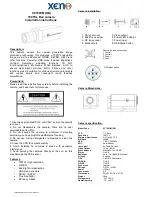
42
•
Operational Reference
Linea SWIR GigE Series Camera
I/O Module Block Diagram
Line Selector =
Line 1 to 4
Physical
Line
Event Driven
Input
inverter
Output
Inverter
Software Driven
Pulse
Generator
LineStatus
Trigger
Line
Activation
Trigger Signal
Timer
TimerEnd Event
CounterEnd Event
Software Trigger
Cmd
Line
Mode
Input
or
Output
Input
Output
Timer and Counter Module
Counter
Line
Debouncer
Event Driven
Trigger
Source
Trigger Module
Output
Line
Source
Signal Driven
Software Driven
Line
Detection
Level
Figure 19: I/O Module Block Diagram
Trigger Overview
The Linea SWIR GigE camera’s line exposures are initiated by a trigger event. A trigger is either the
camera's programmable internal clock used in free running mode, an external input used for
synchronizing exposures to external triggers, or a programmed function call message by the
controlling computer. Triggering modes are described below.
•
Free Running — Line or Frame (Trigger Mode = Off): The camera’s free-running mode has
programmable internal timers for line rate / exposure period and frame rates. Line rate and
frame rates are independent. Frame free running simply means acquire all lines.
•
External Trigger (Trigger Mode = On): Exposures are controlled by an external or internal
trigger signal where the specific input line or source is selected by the Trigger Source feature.
External signal inputs have a programmable time debounce circuit.
•
Virtual Frames: For any Exposure Type, the virtual frame (i.e. the number of exposure lines
per frame) is set by the Image Format Height feature.
Note: Line triggers perform two functions.
•
They start the exposure for the existing line.
•
Read out the exposure from the previous line.
Therefore, a frame of 100 lines will require 101 trigger pulses to complete. The additional trigger is
required to read out the last exposure from the sensor.
When running with virtual frames in continuous acquisition mode or in burst frame mode the extra
trigger becomes the first trigger of the next frame, therefore an extra trigger is not required until
the acquisition stops providing a seamless image without missed lines.
















































